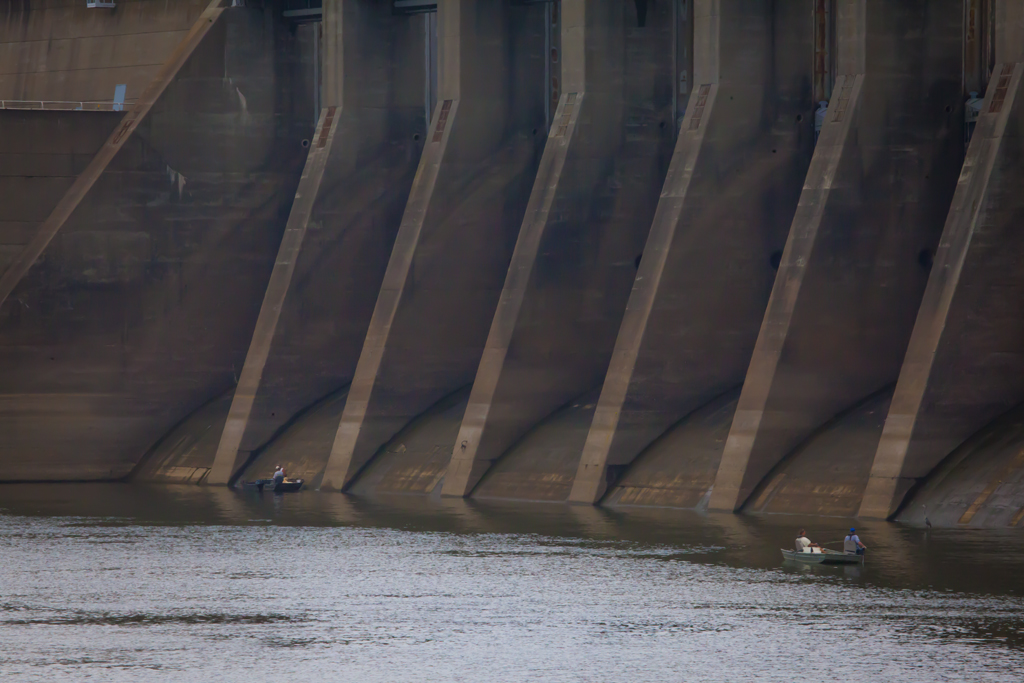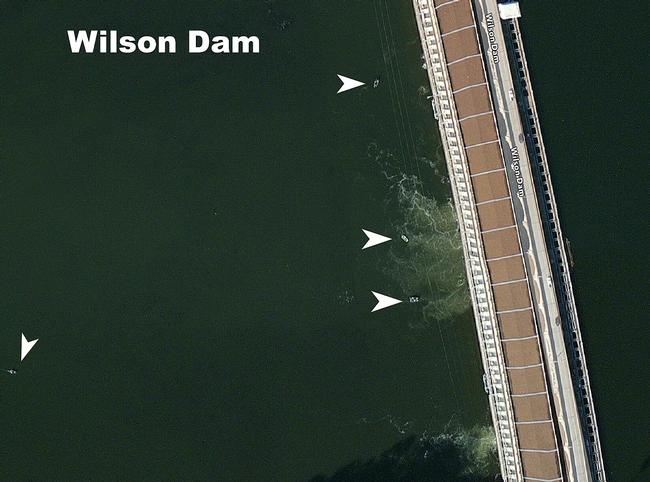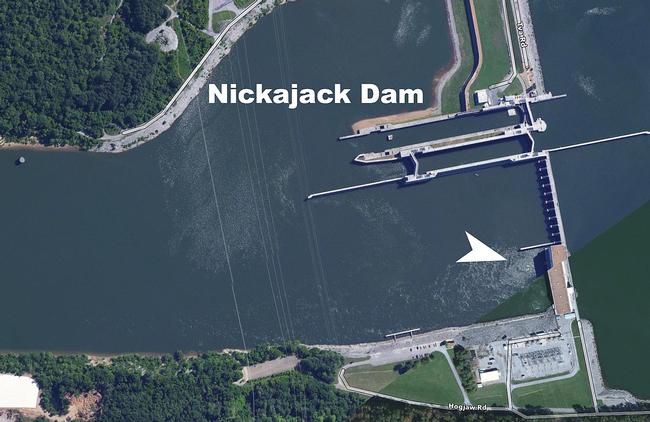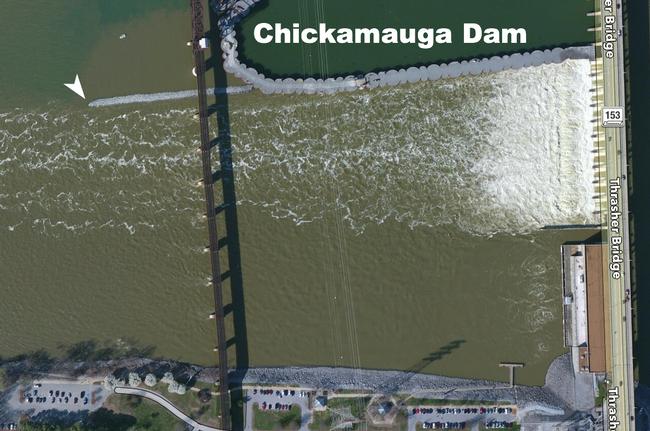4 Keys to tailrace success
A quick primer on when and how to fish tailwaters

If you ask Walmart FLW Tour pro Jonathan Newton where the best tailraces are in the country, he’ll tell you the tailraces of lakes Pickwick and Wilson. If you look at the tournament schedule for June, you’ll see that the fifth 2014 FLW Tour event and the Walmart BFL All-American will be held at Pickwick and Wilson, respectively. Both are hosted by the Florence/Lauderdale Tourism Bureau.
You don’t need a crystal ball to predict where plenty of anglers in both events will be heading.
It’s no secret that dams hold fish pretty much year round, both on the lake side and in the tailrace below. That especially holds true in summer. With the U.S. Army Corp of Engineers consistently pulling water through the dams, baitfish get pulled together on the lake side before being flushed through to the tailrace. It’s hardly a fun ride, as baitfish are often injured or disoriented, but that makes them easy meals for schools of bass waiting below.
Tailrace fishing is not your average offshore fishing, though. Combine strong currents, bass-holding spots that require pinpoint casting accuracy, endless snags and roaming fish, and there is no shortage of challenges to fishing the tailwaters. Yet, anglers such as Newton and fellow Pickwick local Randy Haynes continue to fish them time and again because the extra effort can be well worth it.
Here are their four keys to achieving tailrace success in the summer months.
1. Current and timing

When it comes to tailraces, everything revolves around the current.
“The more they [damkeepers] are pulling water, the better the bite,” says Haynes.
“It’s really a timing deal,” adds Newton. “The fish will position differently depending on the flow. If you time it wrong and are not on the right area when they start pulling water, you’ll miss the bite.”
Each tailrace is different. You’ll need to study them from the water to figure out how changes in current impact fish position and behavior, in order to find the best locations at low- and high-flow times. There are usually little windows, such as the moment water begins being pulled or periods when the current fluctuates, that will trigger fish activity. To maximize productivity during ideal current flows, an angler definitely wants to know the generation schedule for the dam for the given day.
It’s also helpful to know if they’re only generating on one side of the dam. If they’re only pulling water through the left side of the dam, for instance, then that’s where the bass are going to congregate to feed.
One last area to keep in mind is where the current “switches back” against the shore or face of the dam. This large eddy forms in most tailraces where the water swirls back upstream. It’s more pronounced in tailraces where the channel narrows just downstream of the dam, and the flow is “squeezed down” into a more narrow area.
That area of swirling, relaxed current will disorient baitfish and provide a feeding area for bass.
2. Rocks and slack

Even with schools of disoriented baitfish being flushed by them, bass are not about to just sit out in the open and fight the current to eat them.
Instead, they’ll seek out rock piles and large boulders, which create eddies. These bubbles of slack water on the backsides of the structures allow bass to lazily wait, while the current brings the baitfish to them. When a meal washes by, a bass simply has to dart out, eat it and swim back to the calm eddy to wait for the next floundering feast.
Large boulders and bottom depressions that create eddies can be located from above with electronics. However, anglers can often see the eddies right on the surface of the water, indicated by swirling currents or seams between currents of different speeds. The visual indicators are nice because mastery of electronics is not always necessary for location. However, just because an angler can see the eddies doesn’t mean it’s always easy to fish them.
3. Drift or camp
There are two techniques – on good days – for fishing tailraces. If the current is light, an angler can camp on a particular rock pile in hopes a school of bass moves up on it. Just make sure your trolling motor batteries are charged, then go to work.
Most days, though, it’s all about lining up drifts that allow an angler to cast to multiple eddies as the current pushes the boat downstream.
“When the current is really going, you might only get one or two casts at an eddy before you’re past it,” says Newton.
4. Pinpoint power fishing
With such little time to potentially get a lure into the eddy, this is no time to be dragging jigs. Instead, Haynes and Newton opt for lures that can be fished quickly and accurately, namely swimbaits, crankbaits and heavy spinnerbaits.
All three lures will get down to the structure creating the eddy, yet they can also be retrieved quickly. Even still, an angler has to plan his casts so that the current pulls the lure into the eddy at some point during the cast. Otherwise, a bass is less likely to dart out to grab it, especially if the current is really flowing.
Usually, casting just upstream of the target, and at an upstream angle across the structure, will allow the lure to sweep into the strike zone by the time it gets down near the rocks. The length of cast can have an effect, since the current will pull against the extra line and can move the lure a considerable distance. So in heavy flows, it might be necessary to drift by closer to the target.
“There’s a lot to consider and take into account,” says Haynes. “It’s hard to fish tailraces, even for me and I’ve been doing it a long time. If you don’t understand it, you’re missing casts or getting hung up 90 percent of the time. Some guys really take the time to understand it, and those guys catch a lot of fish.”
Final tip: Slack-water structures

Not every productive tailrace structure is a natural eddy-forming feature out “in the flow.” Often, larger man-made structures create expansive slack-water areas, and the seam that forms where that slack water meets moving water is a productive fishing spot in nearly any level of current.
Arkansas pro Kerry Milner fished just such a current seam to win the 2013 Walmart Bass Fishing League All-American on Lake Nickajack. A long, narrow concrete and riprap break wall extending out from the dam created a slack-water area where boats passing through from Lake Chickamauga above could exit the lock without fighting the heavy flows. He parked his boat on the slack-water side, where control was easy, and cast out into the current.
Similar structures exist on most major reservoir systems that support barge traffic. Other man-made features include large cylindrical barge tie-offs, dividers between the main flow and smaller diversion canals, or even spoil piles where construction rubble was piled up underwater.